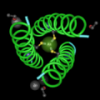Last Friday, we had another in the series of weird DNA structures. (You can see the first here).
I asked the audience to identify the unusual feature in this molecule. Here's the first picture:

tags: DNA structure, DNA , molecular structure, biochemistry
Here's the answer:
Steve L. guessed it correctly. This is not just DNA, it's a DNA:RNA hybrid. I circled a 2' hydroxyl group here to make it easier to see the difference. (Remember - the "D" in DNA stands for "deoxy.") The oxygens are red and it's easiest to tell the difference between the strands if you count them.

For extra credit - where might you find this kind of thing in nature?

Where in nature? During DNA transcription for protein production, I'd think. DNA strand splits apart, RNA forms up until the code for a protein has been copied over, then it heads off to manufacturing.
yep, you win!
Also during DNA replication. DNA polymerases generally can't start new strands. They can only extend from the 3' end of an existing strand, called a primer. Primers are generally made of RNA (because RNA polymerases can start new strands).
Also also, during reverse transcription to convert an RNA virus into a DNA provirus.
And in retrovirues etc ...